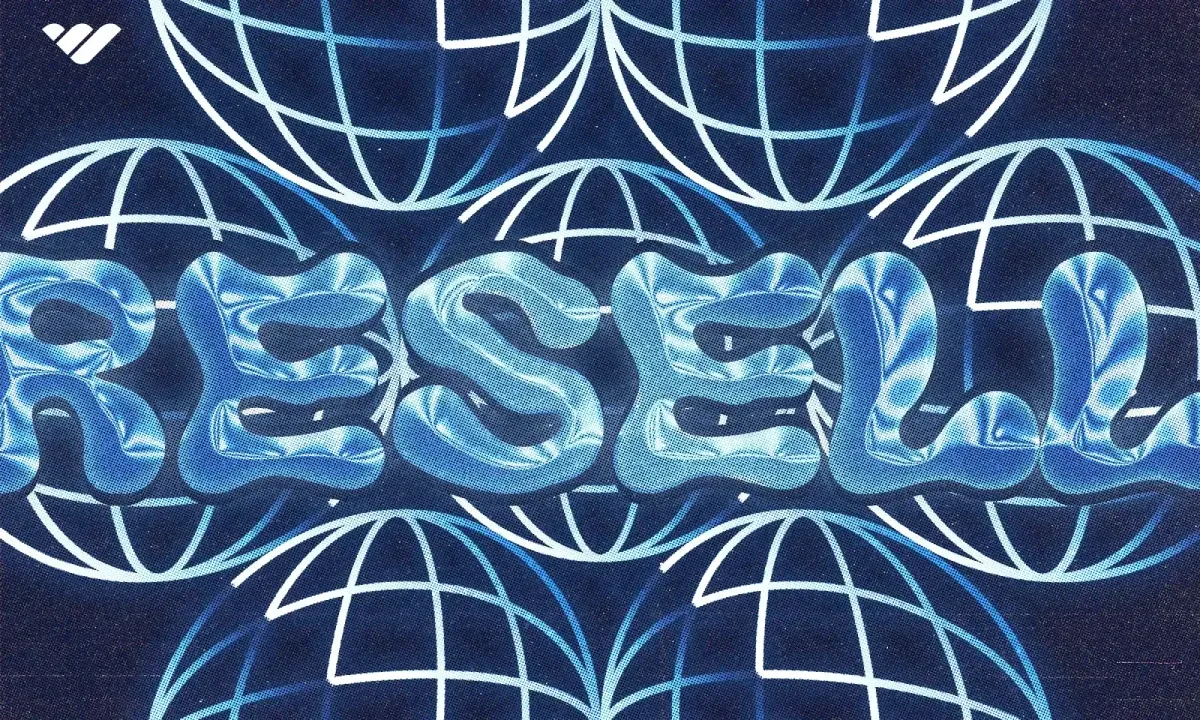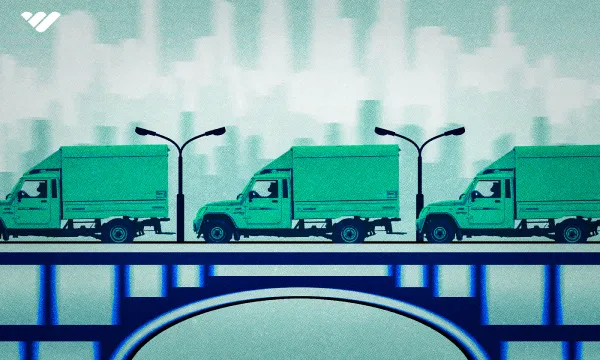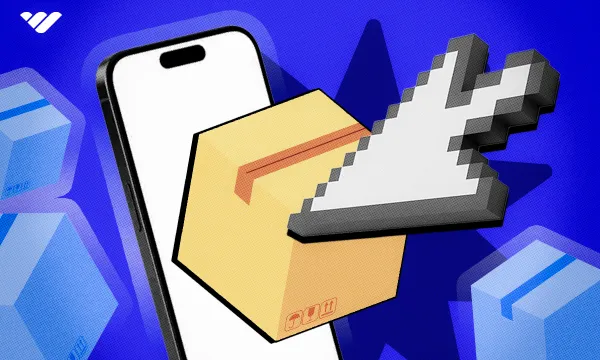When exploring your options for business models as a budding ecommerce entrepreneur, two of the most attractive standouts are dropshipping and reselling. However, while the two share similarities, they’re unique in their own ways with different pros and cons.
In this guide, we’ll go over the differences between dropshipping and reselling, including why one might be more attractive than the other and how to choose between them.
Let’s start by defining each of them.
What is Dropshipping?

Dropshipping is a business model that skips the need for buying inventory as you fulfill orders only when a customer makes a purchase. It’s a specific form of reselling that is in its own category because of its unique fulfillment model.
It’s been a popular ecommerce model for some time, and in recent years, it has created tons of buzz, particularly on TikTok.
How Dropshipping works
Imagine that you own a dropshipping store. When a customer orders a product, instead of going through the picking, packing and shipping yourself, you simply hand off all of the fulfillment process to your supplier which handles this process in the background.
Your supplier will then ship the product directly to your customer under the guise of your brand. This unique method of fulfillment makes for a business model that presents a number of benefits, but it’s not without some shortcomings.
Dropshipping Pros and Cons
Pros
- Low cost startup:
No need to buy or hold physical inventory, giving it low startup costs compared to every other physical ecommerce business model. All you have to do to start is to open up your online shop and market it, which can be free or close to it. - Ability to hold large and diversified inventory:
Dropshipping allows you to hold an assortment of inventory without any additional cost. This can be done most effectively by using a themed store, for example, various tech gadgets if you choose to sell electronics. - Remote operations:
As a dropshipper, you can operate your business with a high degree of locational flexibility because you work remotely with a supplier that is fully responsible for storing and fulfilling the product. - Potential for scale with less initial risk
Since you basically have direct access to your supplier’s entire inventory, you can continue to fulfill orders as they come without having to have the initial risk of taking on a large amount of inventory.
Cons
- Slimmer margins
Since you are making orders from your supplier one at a time, you won’t be able to benefit from the pricing that working with a wholesaler in bulk will give you. You also have to keep in mind to not price your product too much higher than what is the fair market rate, which might not be much higher than your initial cost basis. - Lacking inventory control
Although it’s convenient to be hands-off as a supplier handles all aspects of fulfillment for you, you’re also at the mercy of their ability to execute well, which can be hit or miss at times. For example, sometimes an order is shipped promptly after it has been made in your store, and other times, there might be a delay which you have no control over. - Longer fulfillment times
Dropshipping suppliers are typically based overseas in somewhere like China, so if your customer base is somewhere in the West, you’re looking at shipping times that can easily be two weeks or even longer. For faster fulfillment, for example, one week shipping, you will pay a higher price that might cut into your margins too much. - Less quality assurance
Even if you send a sample of the product to yourself to check it out and get a feel for the fulfillment time, you sometimes can’t be assured of the individual quality of each product that your product might get. This is especially important if you are selling electronics, as any malfunction means a refund or even a potential hazard. - Potential for saturation and price wars
The biggest financial risk in dropshipping is your competition, which is selling the exact same product as you are. Sometimes, your audience overlaps, and the only advantage you’ll have is the price.
Dropshipping Business Examples
While you can dropship products in many categories, there are a few niches that stand out. Here are two:
Innovative and Unique Tech Gadgets
Dropshipping success relies heavily on customers to make impulse purchases on products that look impressive and quickly catch attention on video. Tech gadgets are the most likely to check this box, with innovative examples like a finger bot or a mini ceiling projector being specific standouts.
Home Goods
Another category of products that you can sell as a dropshipper is home goods. People love to buy products that they’ll use every day, making items in the home goods categories an excellent choice. Examples include a mini juicer or a unique tool for cutting and storing avocados.
What is Reselling?

Reselling is a more traditional business model that involves buying inventory that is often brand name product with the goal of selling it for a profit. To find success as a reseller, you must source a well known product for a better price than what is obvious to the general public.
Compared to dropshipping, it is more costly to start, but it has some benefits that could be more appealing based on your individual goals.
Reselling Pros and Cons
Pros
- Higher profit per item
Reselling can often have a higher profit per item. This can especially be true in the case of a hot and trending item such as a piece of streetwear that might fetch more than double its original price. In the case of finding a gem in a thrift shop, a $1 purchase can be worth significantly more than that. - Diverse opportunities
As a reseller, you can operate your business profitably in just about any category that you wish. This means that you can choose to sell products that you are interested in, which will give you an edge both in sourcing and in finding the right customer base. - Full inventory control
You assume full responsibility for control of your inventory when operating a resale business, which has positive aspects to it such as being able to handle shipping and potential returns in the way that will build a positive reputation for your business. - Ability to build customer loyalty
While dropshipping stores may build branded stores, they tend to be more generic than reselling stores which allow more freedom in your ability to brand in a way to build customer loyalty. Each direct interaction with your customer will give an opportunity to foster a relationship and get a repeat customer.
Cons
- Initial investment is required
Unlike dropshipping, reselling requires purchasing an item that you need to hold before you sell it for more. In certain cases this might prove to be quite expensive, like when buying an expensive item like a watch or buying bulk inventory with a high minimum order quantity. - Responsibility of inventory management
While there are many positives of managing your own inventory, it comes with responsibility such as storing and organizing it, which can present logistical issues if you inventory isn’t moving. - Risk of holding unsold inventory
The ideal situation for reselling is to move your inventory as quickly as you are buying it, but this might not always be the case. Sometimes, your inventory won’t sell, which is often due to a change in the market which might be temporary or indefinite. Whether you’ve bought too much of a single item or if you bought an item that is no longer attractive to the market, you hold the risk of having dead inventory that you may be forced to liquidate for a loss. - Can be tricky to scale
While it might be easier to get better margins from reselling products, these might come as individual opportunities that are few and far between. Scaling might mean needing to buy bulk inventory which is above budget, or it might not be possible with the type of item you’re selling if you’re sourcing from somewhere like a thrift store where you have to take what you can get in small quantities.
Reselling business examples
As a reseller, you’ll be able to operate your business in a diverse set of categories, including some that might be aligned specifically with your interest and expertise.Here are two specific examples if you want some inspiration:
Clothing
One of the broadest categories in reselling is clothing. There’s a market for clothing of all types and conditions, from hyped, brand new streetwear to vintage fits. Sneakers also fall under this category. Clothing is a great start to reselling as a beginner as you can start without investing any money simply by selling your own clothing. Doing this will allow you to familiarize yourself with reselling basics, including fulfillment and using different platforms.
Electronics
Electronics as a whole is one of the largest grossing categories in ecommerce, and a good chunk of that market is driven by resellers. As with all categories in reselling, you can sell electronics both used and new, however, in this category you need to be particularly mindful of the condition of whatever you’re selling. Specific items that have a strong market demand that you can target as a reseller include iPhones, gaming consoles, and laptops.
Dropshipping vs Reselling
Now that we have looked at both dropshipping and reselling individually, let's compare the two side by side. This table should help you to come to a conclusion as to which of the two ecommerce business models is best for you.
| Feature | Dropshipping | Reselling |
|---|---|---|
| Upfront Costs | Minimal, as there’s no need to purchase inventory upfront. | Higher, due to the need to buy and store inventory. |
| Inventory Control | None, as suppliers maintain, store and fulfill inventory. | Complete control, as resellers purchase and manage their stock including shipping and storage.. |
| Profit Margins | Generally lower, as the cost includes supplier margins. | Higher, as resellers set their own prices above wholesale costs. |
| Startup Speed | Quick to set up, with immediate market entry possible. | Slower, requiring time to purchase and organize inventory. |
| Potential for Scale | Larger potential to scale with no additional budget, as inventory access is not limited | More difficult to scale as it requires a large budget and profitable inventory source may be limited |
Is Dropshipping or Reselling
Right for You?
By now you should have a good overview of what dropshipping and reselling are, including their pros and cons, and you should be able to decide which one is right for you depending on what your goals and risk tolerance are.
To summarize:
Dropshipping might be your best bet if:
You don’t have much budget and you want a low-cost entry into ecommerce. With dropshipping, you can test out different businesses quickly without having to risk much capital up front. Also, if you happen to enjoy making video content, specifically on TikTok, you will have an edge in this realm as much of modern dropshipping relies heavily on short form video marketing.
Reselling can be a better option when:
You have capital and you’re willing to buy wholesale inventory in bulk, you might want to choose reselling based on higher profit margins and more predictable scalability. The reselling business model best suits entrepreneurs that are ready to invest in and grow a business that has the potential to sustain scale and attract a long-term, loyal audience.
Discover More About Dropshipping and Reselling from the Experts
Whether you want to become a dropshipper or a reseller, embarking on your ecommerce journey with a solid foundation of knowledge and the support of a like-minded community will greatly increase your odds of creating something that will give you the success that you’ve been looking for.
Whop has a diverse selection of private communities that can help you meet your reselling and dropshipping goals. The selection includes groups of various price ranges and backgrounds, including vetted groups and those with a long-standing history of producing successful members. Check out a group so you can join the ranks of ecommerce entrepreneurs that are capitalizing on unique opportunities today!
Check out Whop's reselling communities here, and explore dropshipping groups here.





![Amazon Trends Report [2024] Top Selling Product Categories](/blog/content/images/size/w600/2024/10/X-Amazon-Ecommerce-Trends--2024-.webp)